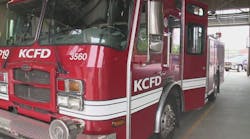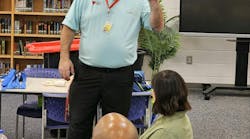Wilkinsburg, PA, Fire Chief Sammie Coley wasn't as eager as his firefighters were when they asked to adopt a ragged, collie-sized, mixed- breed dog a good samaritan carried into their station half-frozen to death during a brutal winter storm.
"I felt it would be neat at first but then for the long haul I felt that everyone wouldn't continue to pitch in and care for her," Coley said. "I just didn't want her to be a burden for anybody."
But for his crew, he cut a deal. The agreement now is paying off for the entire suburban Pittsburgh community, especially its children. "As a way of earning her keep, I told them the dog could be trained to use in the fire prevention program. Then I'd consider (keeping her)," Coley explained.
"Smokey" now is a star, teaching youngsters what to do in emergencies. On command (and for a cookie), she stops, drops to her shaggy brown belly and rolls onto her back repeatedly, simulating the "stop, drop and roll" technique humans should use if caught on fire.
When Firefighter Chip Peterson taps a door and yells "Hot!" Smokey rears up on her hind legs and throws her front paws against the door, showing kids how to feel their door during a fire to see if it's hot. If it is hot, they should find another way out, firefighters tell them.
Firefighters have always had an affinity for dogs, most commonly the typical Dalmatians, since the days canines served as four-legged sirens, running ahead on unpaved streets to alert traffic with their presence and barks that a horse-drawn fire wagon was coming.
Dalmatians were bred as coach dogs. They were kept in firehouses to run with the fire horses, guard the horses and wagons and keep the stables clean of rodents. Some dogs would even venture into burning buildings with their firefighter pals. With the advent of motor power, however, the horses were replaced. The dogs stayed, for a time merely as mascots. Now, like Smokey, their new chore is to teach children fire safety. They are a natural focal point for young kids, who relate better to dogs performing than to firefighters explaining. The dogs aren't limited to Dalmatians anymore, either. Wilkinsburg always has used mixed breeds.
In Springfield, MO, Carolyn Krause's Dalmatians have earned ranking positions in the city fire department, complete with badges, because of their work in local schools, day cares and hospitals. "Becky the Firedog" appeared on billboards, videos, calendars and television promoting fire safety. She taught children for 10 years, achieving the rank of captain. She was buried with a fire department honor guard when she died in mid-1995.
Becky was succeeded by "Poppy," age 6. Poppy now is the one who holds a smoke detector in her mouth as firefighters explain to the children what they are and their importance. Poppy likewise snatches a banner bearing the simple, life-saving code 911 during that portion of the presentation.
But like Smokey, perhaps the most important aspect of Poppy's work is when she actually demonstrates for the children what they should do in case of fire. Dalmatians and many other breeds are extremely intelligent and energetic, and with the proper training can perform seemingly amazing tricks.
On the command "Smoke," Poppy hunches down and crawls on the floor, showing kids how to "get low and go" during fires. "You can even have the dogs and kids crawl under a sheet that people hold to simulate smoke," Krause said. "We do as much work with the dog as space allows."
But the afternoon isn't just an enjoyable one for the students that's forgotten when they trek home. Each receives a postcard of the dog and a firefighter, stamped on the back with Poppy's paw-print autograph. Children are told to give the card to an adult at home and check the batteries in their smoke detectors. They also are told to request a home fire drill that day. Such simple and perhaps startling requests from a young child are likely to snap adults to attention to complete such tasks.
The firefighters really are the ones providing the critical life-saving tips. The dog is simply a way to keep the children focused and reinforce the information. They calm children who may be afraid of firefighters who don't look like normal adults while dressed in their equipment. In turn, the kids learn that if they see such a figure during a scary fire, they should go to them. "They gain for the firefighters what we call the teachable moment," Krause said.
"Spanner," mascot of the Swissvale, PA, Fire Company, is the icebreaker for annual visits at Word of God School during Fire Prevention week in October. When the spotted bundle of energy bounds from the fire truck, kindergartners' faces immediately brighten. Expressions changed from uncertainty about the big yellow machine in front of them to amusement when Spanner ran among them, white tail wagging, pink tongue out. In seconds, the neat military-style line their teachers had ordered them to keep fell apart as the children crowded toward the dog, his head at least stomach-high on most.
Swissvale Fire Chief Ken Johnston tells the children Spanner was named after the type of wrench used to connect fire hoses. After a few minutes of play, however, he ushers a reluctant Spanner back to a fire van and takes center stage himself.
Such efforts have paid off. A grateful father in Springfield told fire officials that his daughter is alive today because of the lessons taught by the late Becky the Firedog.
"The little girl was playing with another child when her clothing caught on fire," former Springfield firefighters union President Larry R. Giggy wrote in a 1991 commendation letter. "Because both children had seen Becky perform the 'stop, drop and roll' during a fire safety program, the man's daughter dropped to the ground and her friend rolled her over to put out the fire. I am very proud to say that the efforts of Springfield's firefighters to educate our children about fire safety are greatly enhanced through the efforts of Mrs. Krause and Becky the Firedog."
Debbie Stinnet, health and safety chairperson for the Parent Teacher Association at Hickory Hills elementary and middle schools in Spring-field, has watched Krause and her dogs teach children for more than five years. "It's a great program, it really is," Stinnet said. "I just think it's a very, very worthwhile program to teach the children. (Fire safety) can't be reinforced enough."
Dog experts and firefighters disagree on one area, though how the dogs are trained and where they live. Krause and Sharon Boyd, secretary of the Dalmatian Club of America, don't like to see dogs live in the firehouse because they feel they can be too easily forgotten about when the firefighters run out to emergencies. They also fear the animals could be killed or injured by the trucks. Rather, they prefer the dogs, whether Dalmatians or other breeds, live at home with a firefighter and receive professional training. "A responsible breeder would never place them with a fire department," said Boyd, of Rosenberg, TX. "This dog has much more to offer than that. This is a family dog."
Dalmatians are people dogs and require positive-reinforcement training, she said. "Train them carefully. Train them with love. Never, never hit them and you will have a dog of a lifetime. This breed is so attentive to their people, if you ever hurt them they won't forget it."
Krause has trained dogs for 10 years and is a judge for the American Kennel Club. She said fire dogs can't be expected to perform like hers by living in a firehouse. "Firemen simply have primary focuses in their lives and dog training is not one of them. I've heard too many unfortunate stories," Krause said. Her dogs are put through every possible situation, such as tail grabbing and ear pinching, to ensure they don't react negatively if a mischievous but well-meaning child hurts or annoys them.
"We're in enough unusual settings that their temperaments can be relied upon," Krause said. "We have never in 10 years had a single incident. Training, training, training are what make good manners possible. Almost any well-trained dog can be trained to do what my dogs can do."
When Wilkinsburg's Smokey sits outside the open firehouse door or in the shady garage, she lures children to come inside, meet the people and see the equipment that one day could save their lives.
"The kids never would stop by until we had the dog," Petersen said. "As far as public relations, this is probably the best thing we've ever done. The kids pay a lot more attention to us."
Paul Muschick covers the Pittsburgh Bureau of Fire for the Pittsburgh Tribune-Review.








